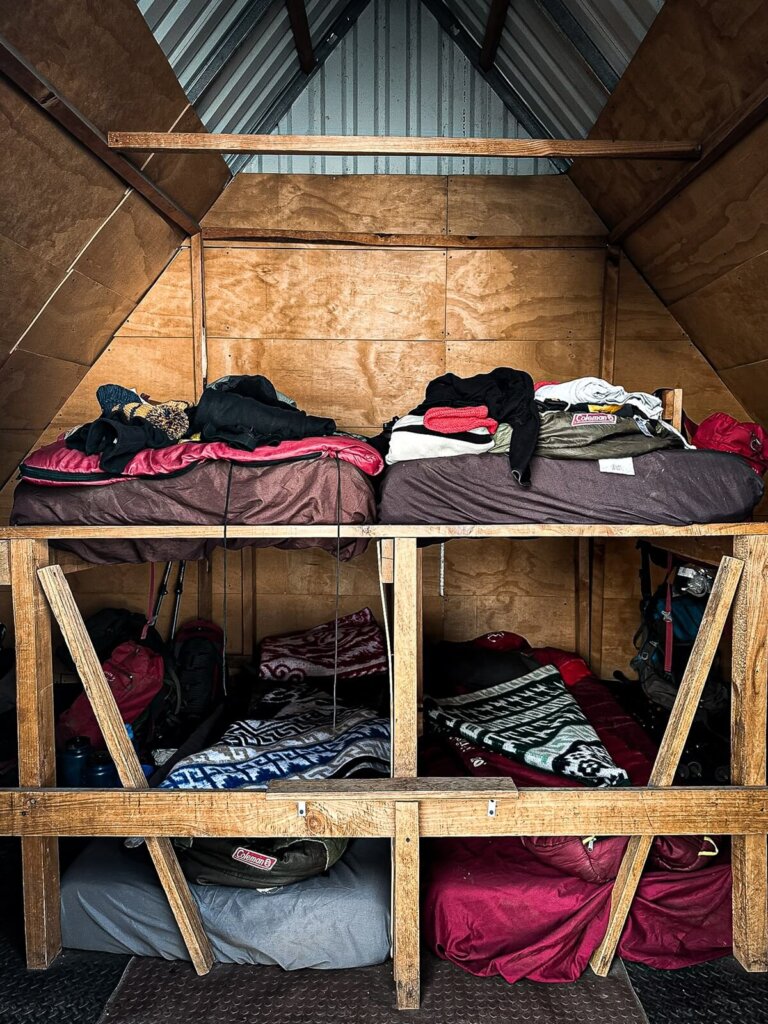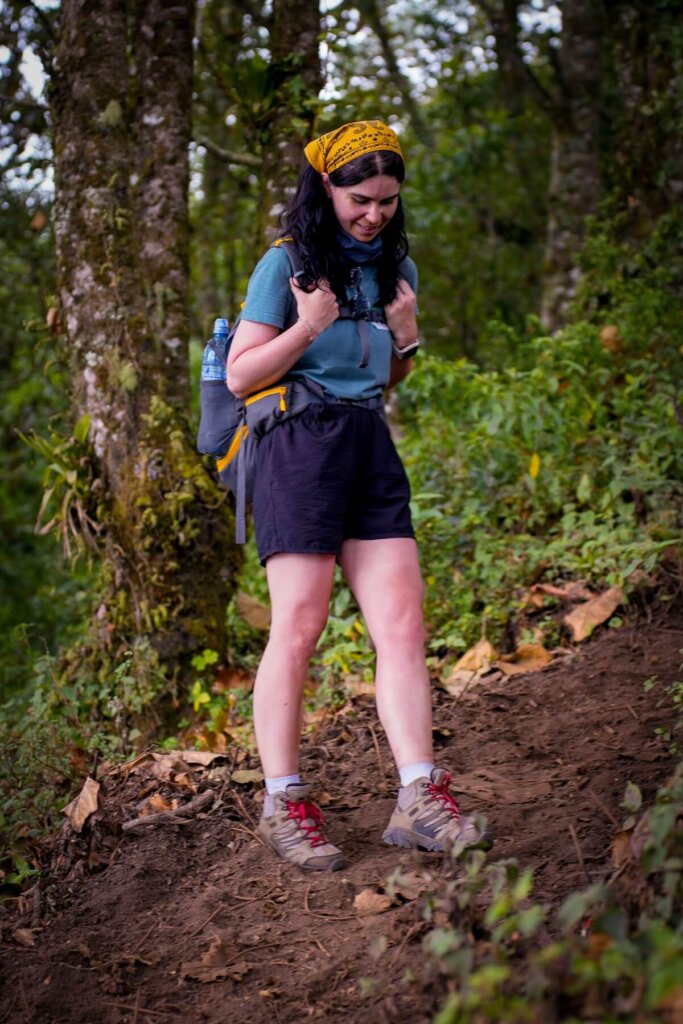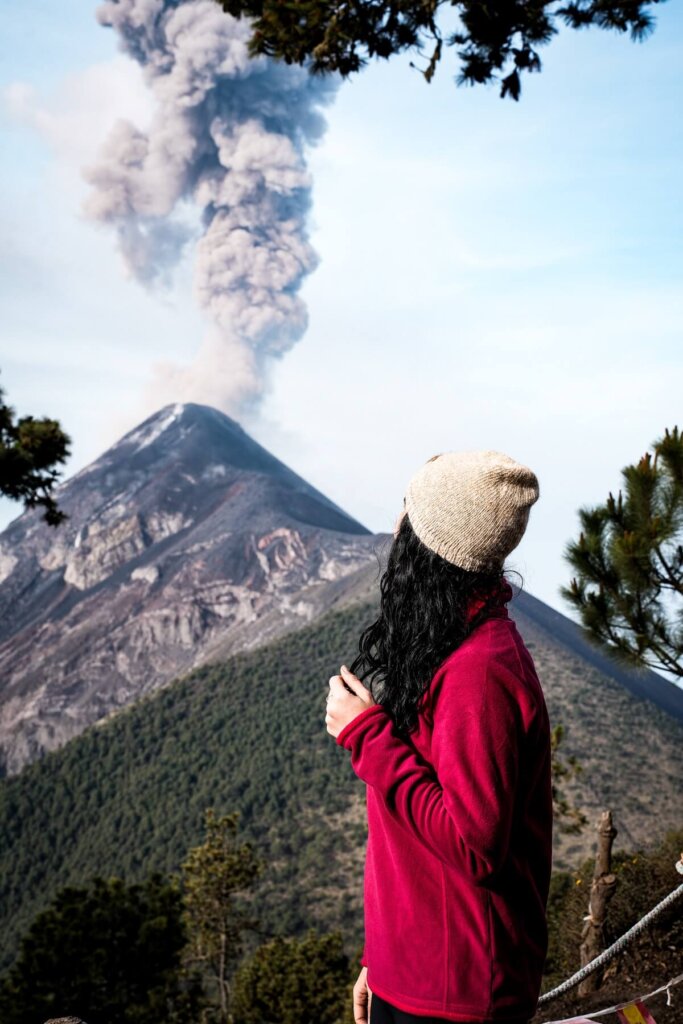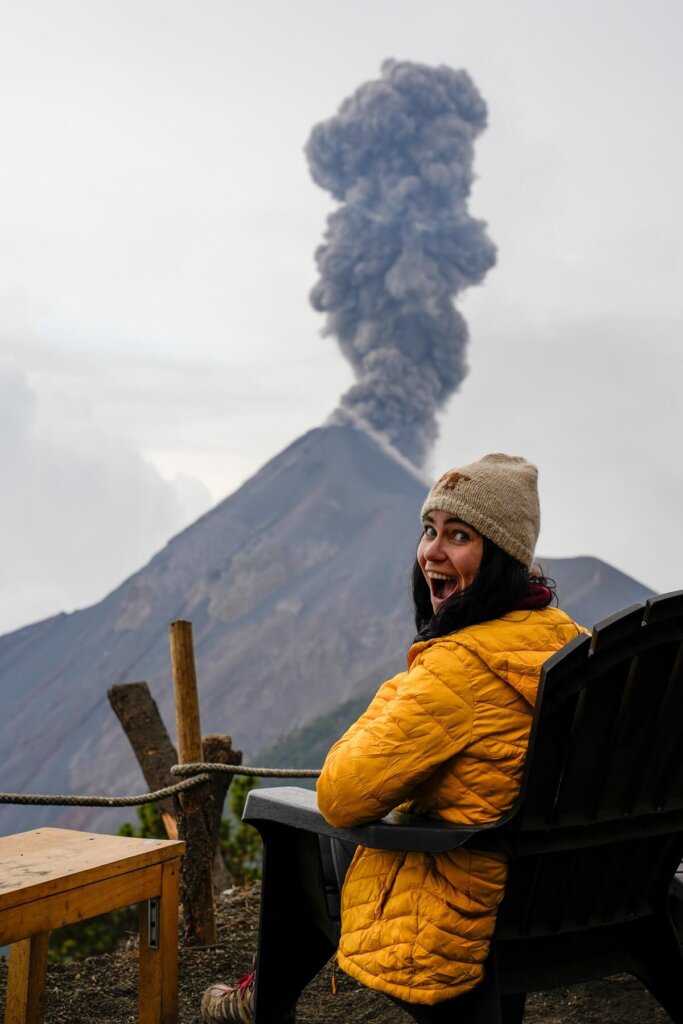Things to Know Before Hiking Acatenango Volcano
Are you planning on hiking Acatenango Volcano during your visit to Guatemala? If so, this guide covers everything you should know before booking this unforgettable experience. We’ll detail the level of difficulty you can expect, the best tour companies to book with, accommodation options, and whether you should hike Volcan de Fuego as well.
If you’d like to see our hike up this volcano, make sure to watch our dedicated Acatenango video on our YouTube channel. For more Guatemala videos, you can also check out our Guatemala series.
Disclosure: This post may contain affiliate links, which means we may receive a small commission if you click a link and purchase something. Clicking these links won’t cost you anything, but it will help us to keep this site up and running! Learn more about our affiliate policy.

Quick Facts About Volcan Acatenango and Volcan de Fuego
Acatenango is one of 37 official volcanoes in Guatemala. This stratovolcano is located to the southwest of the city of Antigua. With a height of 3,976 m (13,044 ft) it’s one of the highest stratovolcanoes in Central America.
Acatenango has two peaks: the northern summit is called Yepocapa (3,800 m / 12,467 ft) and the southern summit is called Pico Central (3,976 m / 13,044 ft). Known historical eruptions of Acatenango occurred between 1924 and 1927.
Acatenango’s twin is Volcan de Fuego (Volcano of Fire) which is currently one of the 3 active volcanoes in Guatemala. Since 1524, Fuego has erupted seriously at least 60 times. Small eruptions occur very regularly, producing plumes of fine ash up to 10 km high, lava and hot pyroclastic flows.
The last major eruption of Fuego was in 2018. This was actually the deadliest eruption in Guatemala since Santa Maria Volcano erupted back in 1902.

Things to Know Before Hiking Acatenengo Volcano
1. Hiking Acatenango is not that difficult…if you have a lot of hiking experience
We saw plenty of videos on social media where people expressed just how difficult hiking up Acatenango was. There are many video titles along the lines of ‘I almost didn’t make it’ or ‘the hardest hike of my life’. Based on the sheer volume of these kinds of video, we were prepared to complete one of the hardest hikes of our lives too.
In reality, it was a much easier trek for us than some of those videos portrayed. Let’s just say that after hiking up the 3,772 m (12,375 ft) tall Volcan Santa Maria with a pretty bad stomach bug, then two days later going on an overnight hike up Zunil Volcano carrying 15 kg on my back (and still not feeling 100%), I don’t think that many hikes would feel remotely as physically challenging as those did at the time.
So, what we’re trying to say here is that if you generally have a good level of fitness, hike a lot, have done some multi-day trekking before or have any high-altitude hiking experience, then hiking Acatenango will definitely feel more like a moderate overnight-trek. Challenging enough to be rewarding but you probably won’t get that ‘almost didn’t make it’ feeling.


2. But, you shouldn’t underestimate Acatenango either
On the other hand, we don’t want you to think that Acatenango will be a walk in the park either. Just because you’ve seen many people’s cool photos and videos on social media, or have just read our thoughts in the above section, doesn’t mean that you won’t struggle to get up there.
If you’ve never hiked before, have a poor level of fitness or some health issues, then there’s a high chance that you’ll find hiking Acatenango very physically demanding. Below we’ve listed the challenges you can face on this route, so make sure to be realistic about your capabilities and don’t underestimate this hike.
- Elevation gain. The trail is pretty much uphill all the way and you’ll gain over 1,200 m (4,000 ft) of elevation just to get to basecamp. The next morning you’ll get the chance to complete the remaining 400 m (1,300 ft) of elevation in just 2 km (1.2 mi) to reach the summit of Acatenango. Plus, you’ll have to descend the volcano that day as well.
- Trail conditions. The trail consists of narrow paths dotted with rocks and tree-roots, dusty sections and a few steep switchbacks. In addition, descending on the second day can be pretty slippery because of all the loose rocks, the dusty surface and the steep sections. It’s so easy to take a wrong step and twist your ankle. We saw many people slipping on the way down. For this reason, we recommend having hiking poles for extra support.
- Weight of backpack. If you’ve never done it before, carrying your heavy backpack up a steep volcano will be an additional shock to your body.

3. You could get altitude sickness hiking on Acatenango
Another major challenge that deserves its own section is altitude sickness. Even if you consider yourself an avid hiker, the altitude could very well impact you. There are many symptoms of altitude sickness, including dehydration, dizziness, headaches, shortness of breath, heavy breathing, loss of appetite, nausea and vomiting. It’s good to remember that anyone can develop altitude sickness and its symptoms can be less or more severe depending on the person.
Altitude sickness is no joke, so make sure that you do some preparation before the hike to get your body ready. This could be as simple as drinking enough water, not drinking alcohol before your hike or having some medication with you just in case. We also suggest going on some acclimatisation hikes, such as up Pacaya Volcano, to test your abilities.
Even if you do all of this, there’s no guarantee that you won’t get altitude sickness. That’s why picking a reliable tour company is important, but we’ll talk more about that further down.

4. Choose your tour company wisely…and book early
Hiking Acatenango in Guatemala is like visiting Machu Picchu in Peru. It’s definitely one of the main reasons people visit the country.
As a result, there are a ton of tour agencies offering the overnight hiking experience. As you can imagine, whilst the hiking route will be the same, there will be a vast difference in quality and price. We recommend picking a reputable company for your own safety and to get the best overall experience. This may come with a higher price tag, but you definitely won’t regret hiking in a smaller group, receiving a greater level of comfort and eating tasty meals.
Things to consider:
- Group size. We saw some VERY large groups hiking up Acatenango. We’re talking about 40+ people. Trust us, the smaller the group size, the better your experience will be.
- Accommodation options. Don’t expect a luxury glamping experience from any of the companies. However, some definitely have nicer camps which include private room options or the chance to share with only a few others. Cheaper companies may only offer tents. Each agency has their own spot on the side of the volcano too, with some providing better views of the volcano than others.
- Food. Again, it’ll be basic, but some companies do provide better meals than others. We were given a fulfilling breakfast before we set off on the first day and a quick lunch the following day when we arrived back at the office. Not every company will offer these extra meals.
- Carrying your backpack. Some companies will take your big backpack 80% of the way up, instead of you having to carry everything on your back the whole way.
- Equipment to borrow. Better tour agencies will offer a wider selection of essential gear to borrow for your hike such as backpacks, hiking poles, shoes and even clothing items. You may still have to pay for some of these items though.
Note. The best companies get booked up quickly. So, if you know your travel dates, make sure to book your tour in advance.

5. Best tour companies to book the overnight Acatenango hike with
Below are a few tour companies to consider booking your overnight Acatenango hiking adventure with:
- Wicho & Charlies. They’re possibly one of the most popular tour companies to book with. Whilst their prices are a little higher, they have pretty good hiking gear to borrow, they take your large backpack up 80% of the way, and you can even book a private cabin if you wish. The size of the group is a little on the larger side, but not as bad as some other companies.
- OX Expeditions. They ‘re another great company to pick. They start the trek earlier than most other tour groups, meaning you can enjoy more time on Acatenango. You’ll have to attend a pre-trek meeting the evening before your hike.
- Camp AKT. A great option if you prefer to be in a small group, as they only allow a maximum of 10 people per tour.
- CA Travelers. Another popular company that also offer shuttle services to places like Lake Atitlan and Lanquin. Their cabins accommodate 2 people, which is a great bonus if you’re a couple. We did the Pacaya Volcano hike with them.
- Old Town Outfitters. They also offer the Acatenango overnight hike, although their price was probably the highest we saw.
- Tropicana Hostel. A popular pick if you’d like to keep the cost of your overnight hike slightly lower. However, they do hike in a rather huge group. Plus, they also offer shuttle services to popular destinations around Guatemala.
We booked with Wicho & Charlies and overall had a fantastic experience with them.
6. Don’t forget about travel insurance
We cannot emphasize enough how important it is to have travel insurance before any trip you make abroad. Now, most travel insurance won’t automatically include cover for all the activities you’re planning on doing during your travels.
For example, if you’re visiting Guatemala, and planning on hiking at high altitudes, then you should make sure to have cover for high altitude trekking in your insurance policy. Shop around to find the most suitable one. You just never know what could happen, and it’s better to be safe than sorry.
We personally use SafetyWing which covers trekking under 4,500m as standard and has an Adventure Sport add-on, which will then cover you up to 6,000m of elevation.


7. The accommodation will be basic
As briefly mentioned above, don’t expect fancy accommodation when hiking Acatenango. After all, you’ll literally be sleeping on the side of a volcano! However, some companies do have slightly more comfortable sleeping arrangements than others. This of course doesn’t mean that you’ll have access to all the luxuries you’re used to. It really depends on how often you find yourself in similar environments (e.g. budget travelling and camping).
Type of accommodations. Some companies only offer tents but many have cabins too. Cabins provide you with better shelter from the cold temperatures, wind and rain. Of course they won’t be luxurious inside and the comfort of the ‘beds’ depends on how used to sleeping in a sleeping bag you are.
Roommates. You can book a private room if it’s available (at greater expense), or you can share with 3, 5 or 7 others. You’ll probably have to sleep very close to your fellow hiking partners. We were in a 6-sleeper cabin, which was absolutely fine for one night and definitely cheaper than a private cabin would’ve been.
Toilet facilities. Most campsites only have the standard hole-in-the-ground-style toilets. We won’t sugarcoat it; they don’t smell particularly nice! There are some of these toilets on the trail too, but honestly it was more hygienic to just find somewhere private in the woods.
Communal areas. Most campsites have a communal area where you’ll eat dinner and breakfast. They also normally have a fire pit with some outdoor chairs and benches, so you can watch Fuego erupting both day and night.
There will be NO electricity, WIFI, or running water (more on that later).


8. You’ll be hiking up Acatenango during the hottest part of the day
One of the things we didn’t enjoy about hiking Acatenango was all the prepping and faffing about before we got going. This isn’t really the fault of the company, as they obviously need to contend with the logistics of turning over groups.
In a nutshell, we had to arrive at the office in Antigua at 7AM. Even though we had the option to go and pick out all the extra gear we needed the day before, we weren’t actually allowed to take it home with us to pack. This meant that we had to pack all of our bags in the morning at the office. We were however provided with breakfast, which was greatly appreciated. It was also nice to start chatting to our fellow hikers.
However, by the time everybody had eaten, packed their bags, filled up their water bottles and stocked up on snacks it was already 9AM before we were in the minivan. Then, it was another hours drive to the trailhead from Antigua.
Once we arrived, we sat down once again to meet our guides, who talked us through what to expect from the upcoming hike. It was 10:30AM by the time we actually started hiking, when the temperatures were already starting to heat up. Again, we appreciate that the late start is for logistical reasons (this is the time the previous groups arrive back from their descent), but if the group is slow and gets up to basecamp too late, they may not have the time to do the additional Fuego hike.


9. But it’s going to be cold in the evening / at night
Whilst you may be a sweaty mess on your way up Acatenango, it’ll be pretty cold at the top. Many travellers backpacking through Central America forget that in some places, such as the summit of a nearly 4,000 m (13,000 ft) tall volcano, it can get really cold, so they don’t pack sufficient gear. Whilst in South America, we still remember a person who rocked up in a T-shirt on our day trip to Palccoyo Rainbow Mountain in Peru, which is nearly 5,000 m (16,400 ft) above sea level. Surprise: he was cold!
We also appreciate that if you’re backpacking through Central America and mainly visiting hot, humid places then you probably won’t want to be carrying fleeces and big jackets. Luckily, by booking with a better tour company, you’ll get the chance to borrow some warmer layers. Many of our fellow hikers borrowed fleeces and down-jackets for the Acatenango adventure.
Possibly the coldest we felt was at the summit of Acatenango whilst waiting for the sun to rise. We definitely needed hats, gloves and our down-jackets.
10. There’s no running water on Acatenango
It should be pretty obvious to most, but it’s worth highlighting that there won’t be any running water at your accommodation.
So don’t expect to be able to shower, flush the toilet, and wash your hands or face. In our full Acatenango packing guide we highlight the importance of bringing hand sanitiser and some wet wipes.
Now, not having running water also means that you’ll be required to carry enough drinking water for yourself, as well as extra to share for cooking. You should calculate roughly how much you’ll be drinking over the course of the hike and add an extra litre or so to that amount which the cooks will use for cooking your dinner and making hot drinks. You’ll drink way more on the way up and it’s important to stay hydrated, so we recommend carrying a little extra if possible. For reference, we had about 4.5-5 litres of water each.
Thankfully, this also means that the weight of your backpack gets lighter and lighter over the course of the trek.

11. Hiking Fuego Volcano is an optional hike (and extra cost)
Hiking up to the ridge of Volcan de Fuego is an optional extra, with many hikers wanting to do it. Standing on an active volcano and experiencing the eruptions so close is definitely something you’ll never forget. However, there are a few things to take into account:
- After hiking all day and gaining over 1,200 m of elevation, you’ll then have to embark on another 4-hour point-to-point hike. From basecamp, you’ll hike all the way down into the valley between the volcanoes and then up again to the ridge of Fuego – which you then have to do again in reverse. The trail is very steep and slippery and our group didn’t get back to basecamp until about 8:30PM having left just after 4PM. So, much of the hike will be done in the dark too.
- It’s an additional cost, usually between Q200-250 per person. Normally you have to pay it to the guides on the day. So, we recommend bringing this amount in cash just in case you decide you want to do it.
- Thankfully, with our company we didn’t need to decide whether we wanted to do it or not when we booked. We could decide on the day when we arrived at basecamp. It’s worth checking if that’s the case with your chosen agency too. Regardless, you have to arrive to basecamp before a certain time in order to be allowed to do it.
- Standing so close to an erupting volcano is not without risk. It can be incredible, but pretty scary and dangerous at the same time.
- The weather is unpredictable and clouds can roll in and cover the volcano quickly, so you could end up exhausting yourself for nothing.
About half of our group decided to go. We actually stayed at basecamp to enjoy the eruptions from there. It was already getting pretty dark and cloudy when our group members left and they didn’t get back until much later. This also meant that they hadn’t had anything sufficient to eat since lunch, which isn’t great when you have to complete another 4 hours of strenuous hiking. Suffice it to say, they were exhausted when they got back. Of course, they didn’t regret experiencing the eruptions from so close but in hindsight some would’ve loved to just relax at basecamp whilst watching the ‘show’ from a chair. Other told us that it was genuinely scary standing so close to the eruptions.

12. Seeing Volcan Fuego erupting from basecamp is impressive too
We decided to stay at basecamp to enjoy the views from there. Luckily, our basecamp was in a great location, so the views were spectacular. Our guides also offered to take us on a short hike further around the side of Acatenango to watch the sunset. Whilst it wasn’t the most amazing sunset because it was cloudy, we got to see Volcan Fuego erupting from a different angle.
So, even if you don’t feel like hiking for an extra 4 hours, your experience won’t be any less memorable. Sitting around a campfire, roasting marshmallows and drinking hot chocolate whilst watching an erupting volcano is pretty unforgettable.


13. But it can be quite scary too
Being so close to an active volcano that erupts every 15 to 20 minutes can be a bit scary. Whilst some eruptions were very quiet, others literally shook the ground under us over on Acatenango.
In the dark we could also see just how far down the side of Fuego the lava travelled. At times it looked pretty close to where the hiking trail up Fuego ends. We can only imagine it’s even scarier when you’re standing on Fuego! The volcano constantly erupts during the night too, so you might get woken up by it a few times.
Plus, let’s not forget that a major eruption could very well occur at any moment. These can be deadly, like the one that happened in 2018.

14. The weather is unpredictable
You’re high in the mountains where weather conditions can be very unpredictable. To increase your chances of seeing Fuego erupting, we recommend hiking Acatenango during the dry season. This is between November and April in Guatemala. That doesn’t mean you can’t hike it in the rainy season, but make sure to check the forecast first. Normally the mornings are fine, with heavy rain in the afternoon.
Please note that even if you hike in the dry season, you can still experience bad conditions and poor visibility.
It’s also worth highlighting that no company will give you a refund if you don’t get to see Fuego due to bad weather.


15. Dogs will be hiking Acatenango with you
If this is your first time in Latin America, it may come as a surprise to you that stray dogs hike up and down the volcano on a daily basis. Don’t be surprised if a four-legged hiker runs past you as you try to push yourself up that steep hill.
Wicho and Charlie’s actually prepared dog food packets that we could take with us to give to the dogs, which was a nice touch. Alternatively, you could also just bring some with you, or perhaps carry some extra water for the dogs too.

16. You’ll meet some cool people on the trek
The reason we enjoy multi-day trekking so much is that it gives us the chance to meet and connect with people from all over the world. On a day trip you may get to have a quick chat with a few people but when you’re stuck together for a day or more, lugging your heavy backpacks, sweating, sharing meals and experiencing an erupting volcano for the first time together, it’s a much better experience that definitely creates closer bonds.
Additional Acatenango Guides:
Acatenango Overnight Hike – A Day by Day Itinerary
Acatenango Packing List – What to Pack for the Overnight Hike
Final Thoughts on Things to Know Before Hiking Acatenango
Hiking Acatenango Volcano had been on our bucket list for years. Whilst we’d seen plenty of photos and videos of Fuego erupting, seeing and hearing it with our own eyes and ears was definitely way more special. Since we hiked in the shoulder season, we had a 50-50 chance of experiencing poor visibility. Thankfully, we got to see Fuego erupt countless times during our time up on Acatenango.
The company we picked was great and we have no problem recommending them. For us, the hike itself was just challenging enough and the payoff is more than worth the effort. We may slightly regret not doing the additional Fuego hike, but we still managed to see some pretty incredible eruptions from our basecamp. Plus, we got to watch the sunrise from the summit of Acatenango, which only about two people who did Fuego the night before managed to get up for.
Have you ever hiked up Acatenango before? If so, what was your experience? If not, we hope that our post helped you prepare for this incredible hike.










